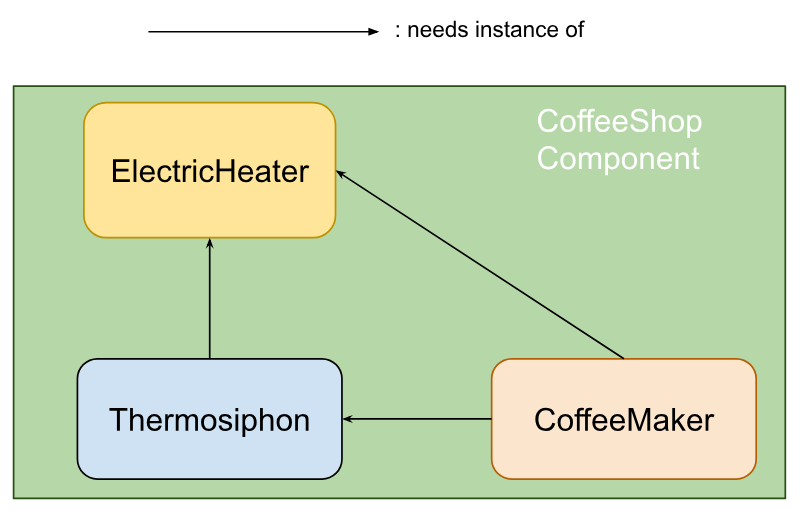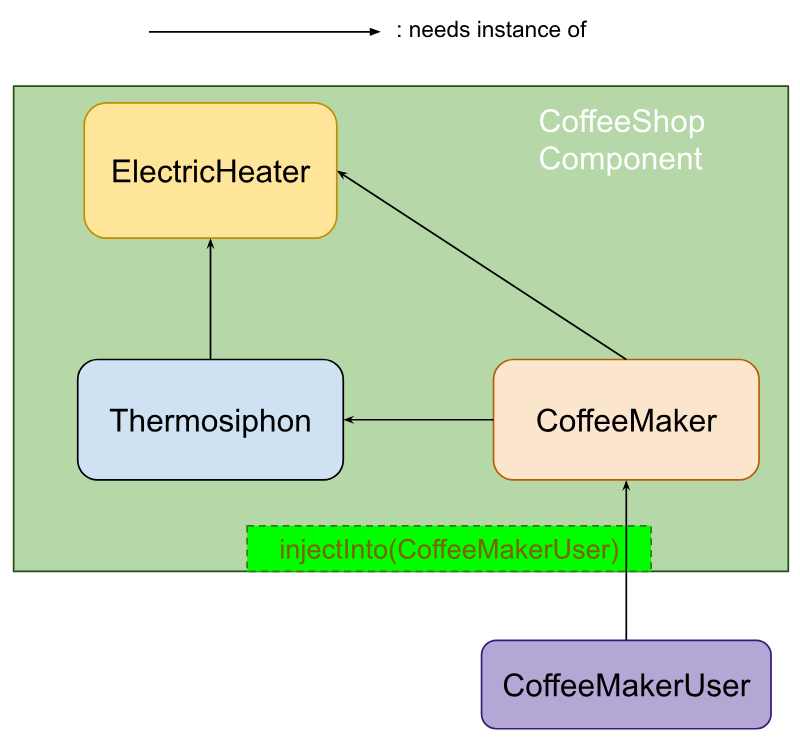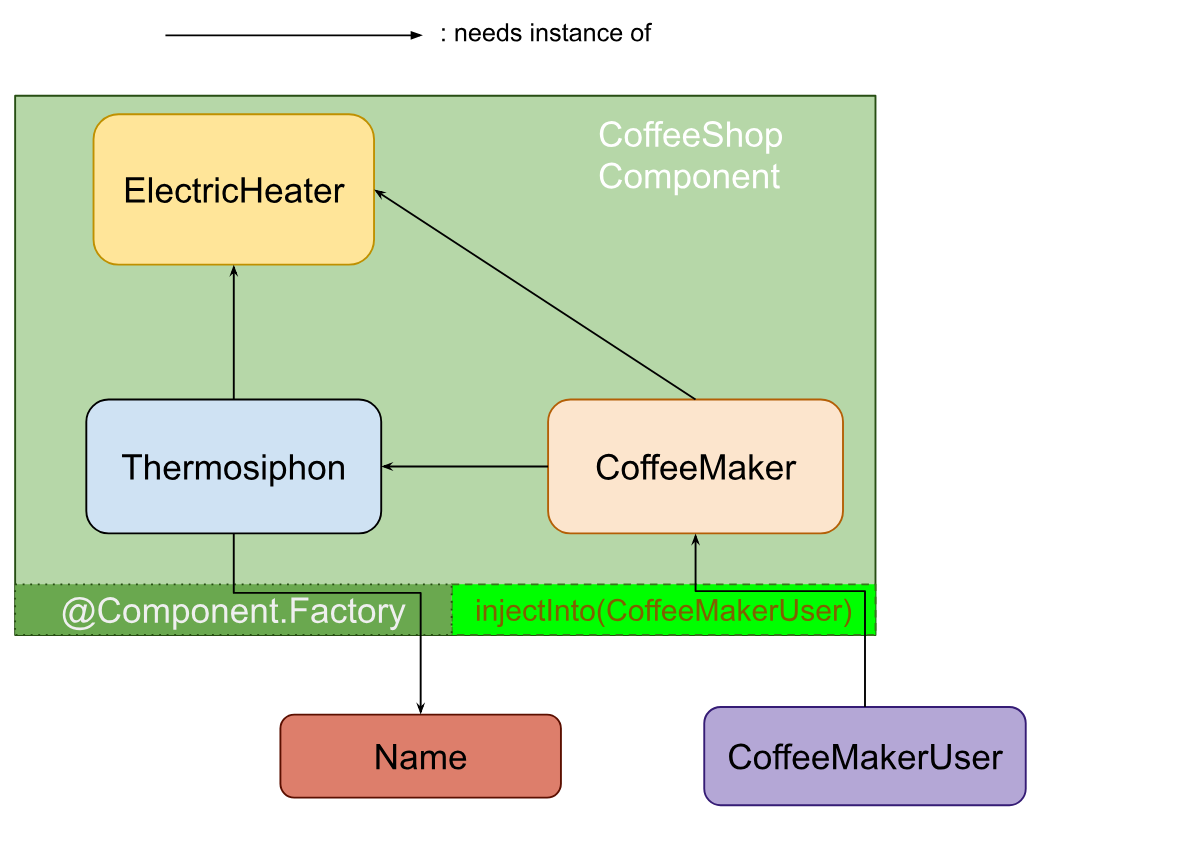Dagger 2: injecting into and from objects not managed by Dagger
Dagger is pretty straightforward when injecting objects in its dependency graph. However, there are situations where Dagger does own the lifecycle of objects. In this post, we will explore some possibilities of interactions with objects whose lifecycle is not managed by dagger.
The starter project
We will start by a Kotlin console application that defined the following graph using Dagger.

The starter project is available here .
Let’s dive into our main subjects.
Injecting an external object to Dagger
Suppose we want to add a name property to the Thermosiphon class and set its value at runtime, for example from the program arguments. We may think of two possibilities:
- Get a
thermosiphoninstance using Dagger and then set the value of thenameproperty. - Set the name property as a constructor parameter and inject it while the component gets created.
The first solution can be achieved as follows:
class Thermosiphon @Inject constructor(private val heater: ElectricHeater) {
var name = ""
// other code
}
fun main(args: Array<String>) {
val coffeeShop = DaggerCoffeeShop.create() // create() is a shortcut to builder().build()
coffeeShop.coffeeMaker.pump.name = "My awesome siphon"
coffeeShop.coffeeMaker.brew()
}
This solution is very simple to implement but it has the inconvenient of performing manual injection by setting the property after the object has been instantiated.
A better way would let Dagger inject the "My awesome siphon" name to the pump coffeeShop.coffeeMaker.pump during the instantiation of the component.
This is done by adding a name parameter to the constructor of Thermosiphon and modifying the component so that it accepts the name parameter as input.
This way, Dagger can bind the name provided to the component to the name constructor parameter of the Thermosiphon.
Dagger offers many possibilities for providing input data to a component.
The recommended way since version 2.22 of Dagger is to use @Component.Factory on an interface that serves as factory for the component.
This interface should define a method that returns an instance of the component and can take as many input parameters as needed. Each parameter must have a @BindsInstance annotation so that Dagger can include it in its dependency tree. This can be illustrated as follows.

In our case, we need to pass a name parameter to the factory as illustrated by the following component code:
@Component.Factory interface Factory{
fun create(@BindsInstance name: String): CoffeeShop
}
We usually define the factory as an inner interface of the component.
The following code snippet shows the new Thermosiphon constructor as well as the new component with the newly created factory.
@Reusable class Thermosiphon @Inject constructor(private val heater: ElectricHeater, val name: String) {
//other code
}
@Component
interface CoffeeShop {
val coffeeMaker: CoffeeMaker
// Allows to return a new component instance
@Component.Factory
interface Factory{
// Declaration of a 'create' method with custom parameters
// The @BindsInstance allows Dagger to inject this instance in its dependecy tree
// The method should return an instance of the component
fun create(@BindsInstance name: String): CoffeeShop
}
}
Injecting a Dagger managed object into a non Dagger managed one
In this part, we investigate the other way around. In other words, we will inject objects managed by Dagger into objects that are not in the Dagger dependency tree. This situation happens when we use libraries that do not let the developer instantiate their objects. In the following, we will learn how to do it with an example.
Suppose that we have a class named CoffeeMakerUser that requires an instance of a CoffeeMaker and the following two constraints: we cannot define a custom constructor (no constructor injection) and we cannot instantiate it in a module.
Taking these constraints into account, we can inject a CoffeeMaker into a CoffeeMakerUser by adding a method in the component that takes a CoffeeMakerUser as parameter.
By calling this method after instantiating the component, Dagger automatically injects a CoffeeMaker from its graph into the CoffeeMakerUser.
This technique is illustrated as follows.

The following steps show how to implement it.
- Add
@Injectto theCoffeeMakerUserclass.
class CoffeeMakerUser {
@Inject lateinit var coffeeMaker: CoffeeMaker
}
- In the component add a function that takes a
CoffeeMakerUserparameter. This function makes Dagger capable of injecting aCoffeeMakerfrom its dependency tree into aCoffeeMakerUser.
@Component interface CoffeeShop {
val coffeeMaker: CoffeeMaker
// allows to inject object from Dagger graph to another object not in the dependy graph
fun injectInto(coffeeMakerUser: CoffeeMakerUser)
}
- After creating the component, call the injection function by passing it the an instance of
CoffeeMakerUser.
val coffeeShop = DaggerCoffeeShop.factory().create()
val coffeeMakerUser = CoffeeMakerUser()
coffeeShop.injectInto(coffeeMakerUser) // Injects objects into the coffeeMakerUser
coffeeMakerUser.coffeeMaker.brew() // coffeeMakerUser can use the injected coffeeMaker
For example, Android Activities are instantiated by the Android SDK, thus Dagger cannot automatically inject into these objects.
We can go even further by combining the two techniques studies in this post as illustrated by the following figure.

Conclusion
In addition to managing its own dependency tree, Dagger is capable of interacting with objects which are not part of it.
In this post, we have first seen how to use @Component.Factory to inject external object into a Dagger component. After that, we have seen how to inject objects from a Dagger component into another object not managed by Dagger.
Using Factory to inject external objects
Injecting into objects not managed by Dagger
